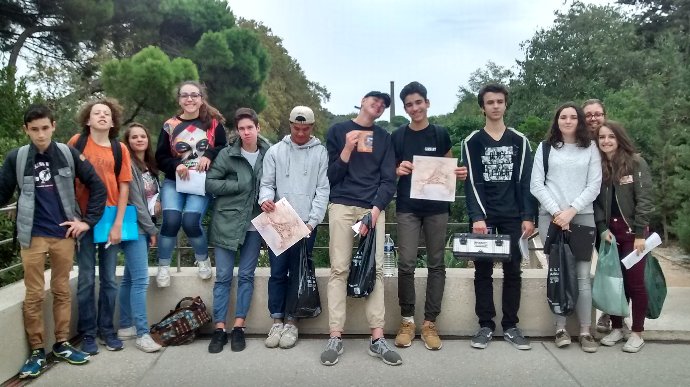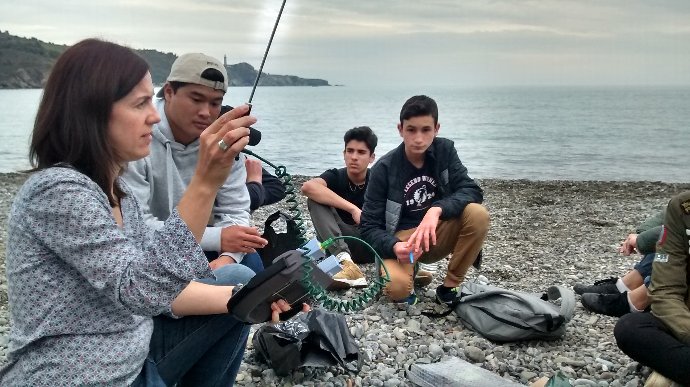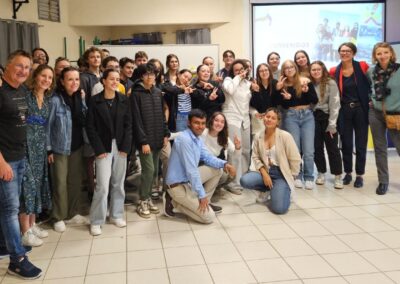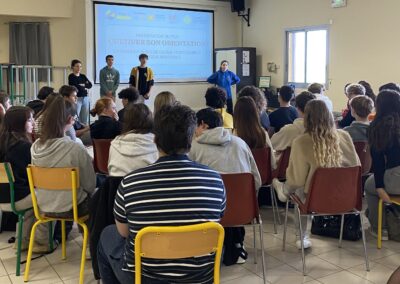Dans le cadre de la section européenne anglais du LEGTA de Théza, 13 élèves des classes de 1° STAV et 1ère S, se sont rendus sur le site de Paulilles.

Le programme pédagogique et éducatif de cette sortie était :
- Visite guidée du site en anglais,
- Visite de l’exposition en anglais : récolte d’informations historiques, géographiques, et chimiques sur la fabrication de la dynamite
- Travail de récolte de données physico-chimiques sur le site et analyse de ces données (aprés lecture du protocole et des fiches techniques en anglais).
Les brèves qui suivent ont été rédigées par les élèves :
Guillaume et Arnaud : a guided Tour of Paulilles
We were a group of 12 students from The English European Section of Legta Federico Garcia Lorca from Théza, to spend an afternoon on the “Sité classé de l’Anse de Paulilles”. It is situated on the Mediterranean coast of the French department of Pyrenees-Orientales and it used to provide a lot of countries in the world with explosives such as for the building of the Panama Canal. It opened in 1870 because France was at war with Prussia. Our visit started with a explanation of the beginnings of the dynamite factory. Then, we went on to the exhibition and continued with the beach on which we made some physical and chemical measures. Finally, we walked around the location together, climbed the watching tower and looked at the models.
Romane et Manon : the exhibition
After the guided tour, we went to the exhibition about the dynamite plant of Paulille. There were 26 panels, one for each letter of the alphabet, to explain the
history of this factory. We will talk about two panels in particular.
First the « Nobel » panel explains the role of Mr Nobel, the scientist who found the way to stabilise the nitroglycerine . Indeed, this solution was very instable, if it was shaken or in a hot environment it exploded. Nobel worked 10 years to stabilize the nitroglycerine and he finally found an absorbant called glycol to add into the solution which became a paste.
Secondly the « dramas » panel explains the different explosions which ocurred on the site. Some explosions didn’t kill anybody but, the biggest explosion killed 50 people among whom 20 women. Nobel appologised for this explosion and all the damages caused by the dynamite by creating the « Nobel price » which awards
people for chemistry, physics, litterature, peace and economy.

Joris et Manu : report about our visit to Paulille
We walked to the beach of Paulilles to make science tests. We took some sampling of water and measured the atmospheric pressure. We used laboratory equipement like VTT and we found it was 1018 Hpa. We also measured the hydrometric degrees and found it was 76,7 % as well as the water and air temperature. The water was 15°C and the air was 21°C. After we mesured the pH of sea water with PH paper and we found it was 6. So it’s acid.
And we took some sea water and put it into a plastic graduated test tube and added three drops of silver nitrate and it triggered a white reaction which proved there was chloride in the water and nitrates as shown by the nitrate paper.
Eva et Diane : the location
Paulilles is nestled between the Cape Béar and Cape Oullestrelll, Paulilles bay has a landscape that sharply contrasts the world of wine making and sea.
On this site, we saw a magnificent botanical garden with some rare species, four models of the landscape, a panoramic tower, some sheds, as well as some rare birds. Plants are greatly
diversified. It is a Natura 2000 site, opened to the public in 2008.
Florian et Axelle :
During the guided tour, our class liked the guide very much because he was very cool and had a real sense of humour. The topic, which was about the history of Paulilles, was so interesting. We walked around this big compound and we saw beautiful landscapes. We made physic mesures and it was very funny for a lot of us…




